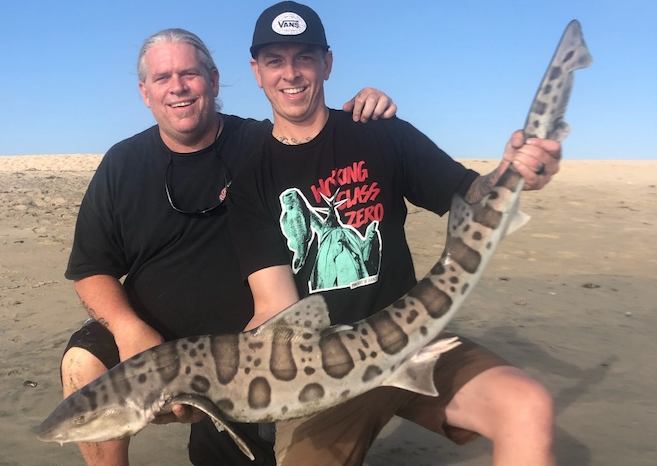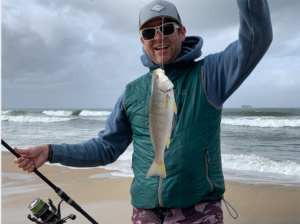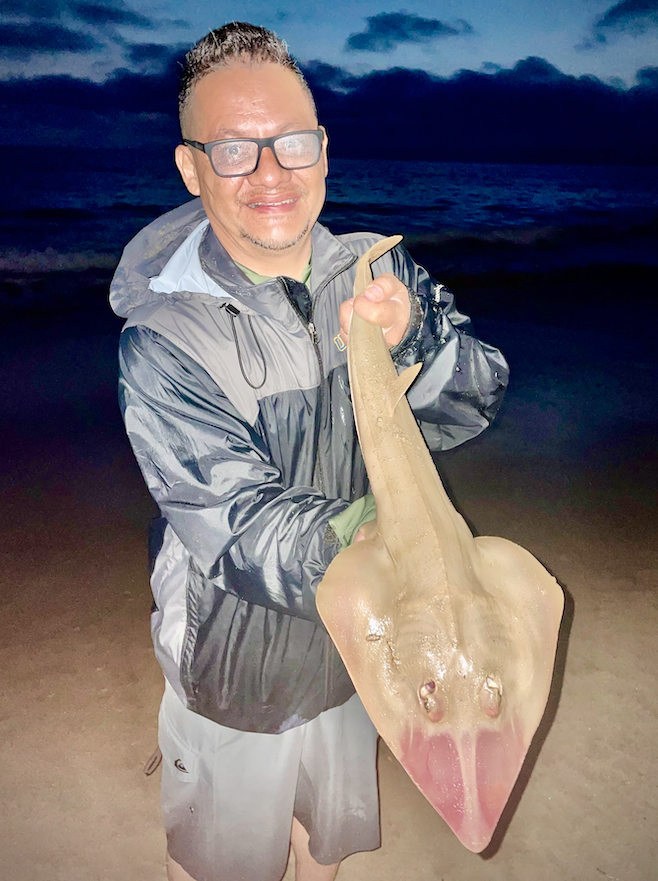
BY BEN HERVEY-MURRAY
Corbina
The prince of the sand come summertime, catching a decent corbina in Southern California is up there with the most fun (and hardest) surf fishing targets, even with a pro guide.
The first thing to understand is that corbina have evolved excellent eyesight due to their preference for feeding on small items in the shorebreak. They will likely scope out heavy non-fluorocarbon leaders, big hooks and clumsy rigging in an instant. Subtlety is key. Think 4- to 6-pound fluorocarbon leaders, tiny beads and swivels, the lightest sinker you can get away with and a small J hook (size 6 or 8) suited to using small sandcrabs or sandworm sections as bait.
Aside from rigging, the two keys to catching a big corbina are fishing in water adjacent to beds of sand crabs, and staying out of sight. The hardest corbina to catch, in my experience, are the ones that you can see. If you can see them, they’re likely to see you too. So, whilst shallow water stalking tactics seem idyllic, it’s a hard ask to catch one this way unless you’re at the top of your game. A far more reliable tactic is to target the pockets of water just off the shorebreak adjacent to beds of sand crabs where the corbina await an easy meal in a few feet of water.
Spring also sees corbina inhabit harbors, jetty systems and bay areas, as well as open beaches, and here a small section of ghost shrimp is a killer bait. In-fact, this tactic has accounted for several record-size fish over the years, particularly in spring and early summer.
Tackle-wise, an 8- or 9-foot rod rated for 4 to 8-pound line works well combined with a 2500-size spinning reel (a Penn Battle III DX 2500 is my current favorite) loaded with 10-pound braid main line and a long (10 foot) fluorocarbon leader above the sinker. Bite leaders are always 4-pound fluorocarbon and a small bunch of crabs on a size 8 hook consistently out-fishes most other baits. Watch the water temperature closely – 63-degrees seems to the magic threshold when sand crabs and corbina kick into gear for the season.
California halibut
The California halibut hits peak breeding season around May, making spring and early summer the perfect time to target the flatfish on beaches or in bays and harbors. The two main methods that do the business are small livebaits fished on trap rigs – consisting of a small J hook to secure the bait through the nose with, and a small treble hook to nick in the bait towards the tail – or, alternatively, artificial bait fish imitations.
Artificials are the most popular (and easiest) option with a drop-shotted white fluke or simple jerkbait in sardine or similar patterns highly effective. Set-up-wise, something with a bit of backbone to punch a jerkbait out a decent distance into the surf is ideal; 9- or 10-foot spinning rods rated to cast 1- to 3-ounce baits with 15- to 30-pound braid main line is idea. Add a short 20-pound fluorocarbon leader for low-visibility purposes and hit the morning after a grunion run on a sandy, structured beach and you’ll have some fun.

Croaker (yellowfin & spotfin)
I target yellowfin and spotfin croaker in a slightly different way to most other fish in the surf, with spotfin in particular a different beast to almost anything else. Yellowfin croaker are relatively easy to catch and form the backbone of many guided sessions in spring and summer, whilst spotfin are more of a unicorn species that I expect to see few times a year rather than on a daily basis.
Yellowfin croaker, it seems, eat just about anything. I see them regularly caught on jerkbaits, spoons, grubs, squid strips, shrimp, sand crabs, bloodworms and Fishbites baits. They’re not fussy eaters and a double dropper loop rigged with size 6 circle hooks and 20-pound fluorocarbon catches them consistently combined with most standard, fresh surf fishing baits. They show a preference for sitting a little further back in the surf than a corbina or surf perch – just behind the white water seems to be the sweet spot. A wired sputnik-style surf sinker helps sit the bait in the zone for the maximum amount of time.
Spotfin croaker, by contrast, are highly fussy eaters and I can recall catching just one on 20-pound fluorocarbon, compared to many on 10-pound fluoro leaders. This is despite using 20-pound far more than 10. They show a distinct preference for small baits, small hooks and light lines.
The perfect grade of tackle for spotfin is a size 8 or 6 circle hook, the lightest fluorocarbon leader you can get away with (6- to 15-pound max), and a small bait like a single sand crab, or a 1-inch section of bloodworm or sandworm grub. Anything bigger results in fewer spotfin hits, in my experience. They don’t mind shallow water and will inhabit similar areas to corbina with a marked preference for warm, shallow, sandy beaches with plenty of crabs around.
The real trick with spotfin is to not give them any slack line at all, once hooked. They’re experts at riding themselves of hooks with repeated head shakes and a slack line is a sure-fire recipe for a lost spotfin. I estimate that only around 50% of hooked spotfin make it to the beach for this reason, and due to them having some pretty gnarly spikes and spines on their back and gill plate, which can make short work of light leaders if you’re unlucky. A big spotfin caught off the beach is one of the West Coast’s finest fish, in my opinion.
Surfperch
Spring marks the barred surf perch’s peak birthing season, and for this reason lots of the larger-grade females will be stacked up on sandy beaches ready to pop with dozens of miniature surf perch babies. This also means they’re hungry and highly predatory, making a host of surf fishing tactics viable for big hit of perch, with the three big catchers being small grub-style baits like the ubiquitous Gulp! Sandworms, sand crabs and baitfish imitation lures such as a small jerkbait.
The first two will catch anything in front of you species-wise, including lots of fun-size dink perch, whilst the larger hard bait offering will be more selective in terms of fish size. You’ll also be in the game for a halibut or two. Location-wise, perch will come in ridiculously close to feed on sand crabs, clams and sand worms so make sure you’re fishing into well-structured water close to the shore and near bait sources. Keep moving, too, as surf perch are often stacked up in very particular areas and holes, rather than being more evenly spread throughout the shoreline.
Leopards, soupfin sharks & rays
My personal favorite target in the spring, most beaches in SoCal will see a good run of leopard sharks and soupfin during the spring and provide excellent sport on spinning tackle and casted baits.
Tackle-wise, don’t go light and always use a wire leader. My go-to set-up for this style of fishing consists of a 12 or 13-foot spinning rod rated to cast an 8-ounce sinker, a 6000 or 8000-size spinning reel loaded with 40 to 60-pound braid topped with a 12-foot, 80-pound mono casting / rub leader.
The rig is always a pulley or C-rig-style set-up with a heavier mono rub leader above 170-pound wire and a pair of 10/0 circle hooks. With this rig I can cast a decent size bait – half a mackerel, bonito head, croaker, perch… any sort of large, fresh fin fish – plenty far enough to put in the right zones. The kayak comes into play for bait deployment on certain beaches but I’m less bothered about this as the fish increase in numbers through the spring and summer months. Always use a fresh bait (not frozen) for these species.
The next thing to consider is how the fish find your bait. Houndsharks like leopards and soupfin have an incredible ability to sense fresh blood in the water, which is how they find most of their food items. We can take advantage of this trait by using the aforementioned fresh baits at peak tidal cycles and periods when the water is moving rapidly in or out. This help carries the scent trail from your bait to the shark, resulting in them swimming up the scent trail and finding your bait. Leopards enjoy sandier beaches whilst soupfin and bat rays show a preference for beaches with reef or kelp systems nearby. Bat rays seem to behave more like a cow, grazing the areas just behind the surfline for food on periods of slacker tide.
For this style of fishing, I highly recommend getting to know a good local spot and what sort of tides and moon cycles trigger a good shark and ray bite. Knowing where rocky hazards are situated by scouting the beach on a minus low tide is a good idea, too. As always when shark fishing, carry a substantial pair of unhooking pliers on your person plus cutters, gloves and a proper dehooking device. Fishing in pairs is also a good idea, particularly if big rays are on the agenda. Handling and unhooking one of the 100-pound-plus giants solo isn’t much fun, trust me.
Others
Depending on where you live on the West Coast, a host of other species come into play in spring. Many are highly-predatory species such as the white seabass, striped bass, the true saltwater bass species (calico, sand, bay) and corvina, if fishing around the San Diego area, that are caught on the same tackle we use to target halibut and similar species. Think baitfish-imitating jerkbaits, swimbaits, spinnerbaits, spoons and jigs covering well-structured beaches and breakwaters with a nearby reef or kelp field at dawn or dusk with a nice bit of tide moving things (and baitfish) around.
Oddities like shovelnose guitarfish also become more common along with a multitude of small shark and ray species, most of which I actively avoid whilst shark fishing but which can be fun on light tackle. Shovelnose guitarfish, in particular, are always nice to see and love feeding on sand crabs in warm, sandy seas. Bonus points if you catch an ultra-rare banded guitarfish.




